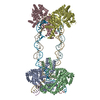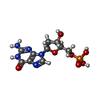[English] 日本語
 Yorodumi
Yorodumi- PDB-8eb5: Tandem of Hermes transposase BED domain in complex with the quasi... -
+ Open data
Open data
- Basic information
Basic information
| Entry | Database: PDB / ID: 8eb5 | ||||||
|---|---|---|---|---|---|---|---|
| Title | Tandem of Hermes transposase BED domain in complex with the quasi palindrome of its transposon left-end | ||||||
 Components Components |
| ||||||
 Keywords Keywords | DNA BINDING PROTEIN/DNA / BED domain / zinc-binding domain / transposase / DNA BINDING PROTEIN-DNA complex | ||||||
| Function / homology |  Function and homology information Function and homology informationprotein dimerization activity / DNA binding / zinc ion binding / identical protein binding / nucleus Similarity search - Function | ||||||
| Biological species |  Musca domestica (house fly) Musca domestica (house fly) | ||||||
| Method |  X-RAY DIFFRACTION / X-RAY DIFFRACTION /  SYNCHROTRON / SYNCHROTRON /  MAD / Resolution: 2.5 Å MAD / Resolution: 2.5 Å | ||||||
 Authors Authors | Lannes, L. / Dyda, F. | ||||||
| Funding support |  United States, 1items United States, 1items
| ||||||
 Citation Citation |  Journal: Nat Commun / Year: 2023 Journal: Nat Commun / Year: 2023Title: Zinc-finger BED domains drive the formation of the active Hermes transpososome by asymmetric DNA binding. Authors: Laurie Lannes / Christopher M Furman / Alison B Hickman / Fred Dyda /  Abstract: The Hermes DNA transposon is a member of the eukaryotic hAT superfamily, and its transposase forms a ring-shaped tetramer of dimers. Our investigation, combining biochemical, crystallography and cryo- ...The Hermes DNA transposon is a member of the eukaryotic hAT superfamily, and its transposase forms a ring-shaped tetramer of dimers. Our investigation, combining biochemical, crystallography and cryo-electron microscopy, and in-cell assays, shows that the full-length Hermes octamer extensively interacts with its transposon left-end through multiple BED domains of three Hermes protomers contributed by three dimers explaining the role of the unusual higher-order assembly. By contrast, the right-end is bound to no BED domains at all. Thus, this work supports a model in which Hermes multimerizes to gather enough BED domains to find its left-end among the abundant genomic DNA, facilitating the subsequent interaction with the right-end. | ||||||
| History |
|
- Structure visualization
Structure visualization
| Structure viewer | Molecule:  Molmil Molmil Jmol/JSmol Jmol/JSmol |
|---|
- Downloads & links
Downloads & links
- Download
Download
| PDBx/mmCIF format |  8eb5.cif.gz 8eb5.cif.gz | 88.1 KB | Display |  PDBx/mmCIF format PDBx/mmCIF format |
|---|---|---|---|---|
| PDB format |  pdb8eb5.ent.gz pdb8eb5.ent.gz | 62.9 KB | Display |  PDB format PDB format |
| PDBx/mmJSON format |  8eb5.json.gz 8eb5.json.gz | Tree view |  PDBx/mmJSON format PDBx/mmJSON format | |
| Others |  Other downloads Other downloads |
-Validation report
| Summary document |  8eb5_validation.pdf.gz 8eb5_validation.pdf.gz | 433.2 KB | Display |  wwPDB validaton report wwPDB validaton report |
|---|---|---|---|---|
| Full document |  8eb5_full_validation.pdf.gz 8eb5_full_validation.pdf.gz | 434.4 KB | Display | |
| Data in XML |  8eb5_validation.xml.gz 8eb5_validation.xml.gz | 6.2 KB | Display | |
| Data in CIF |  8eb5_validation.cif.gz 8eb5_validation.cif.gz | 7.5 KB | Display | |
| Arichive directory |  https://data.pdbj.org/pub/pdb/validation_reports/eb/8eb5 https://data.pdbj.org/pub/pdb/validation_reports/eb/8eb5 ftp://data.pdbj.org/pub/pdb/validation_reports/eb/8eb5 ftp://data.pdbj.org/pub/pdb/validation_reports/eb/8eb5 | HTTPS FTP |
-Related structure data
| Related structure data |  8edgC  8sjdC C: citing same article ( |
|---|---|
| Similar structure data | Similarity search - Function & homology  F&H Search F&H Search |
- Links
Links
- Assembly
Assembly
| Deposited unit | 
| ||||||||
|---|---|---|---|---|---|---|---|---|---|
| 1 | 
| ||||||||
| Unit cell |
| ||||||||
| Components on special symmetry positions |
|
- Components
Components
| #1: Protein | Mass: 9150.765 Da / Num. of mol.: 1 / Mutation: None Source method: isolated from a genetically manipulated source Source: (gene. exp.)  Musca domestica (house fly) / Plasmid: pET15b / Details (production host): no purification tag / Production host: Musca domestica (house fly) / Plasmid: pET15b / Details (production host): no purification tag / Production host:  |
|---|---|
| #2: DNA chain | Mass: 5201.396 Da / Num. of mol.: 1 / Mutation: None / Source method: obtained synthetically / Source: (synth.)  Musca domestica (house fly) Musca domestica (house fly) |
| #3: DNA chain | Mass: 5210.411 Da / Num. of mol.: 1 / Source method: obtained synthetically / Source: (synth.)  Musca domestica (house fly) Musca domestica (house fly) |
| #4: Chemical | ChemComp-ZN / |
| #5: Water | ChemComp-HOH / |
| Has ligand of interest | N |
-Experimental details
-Experiment
| Experiment | Method:  X-RAY DIFFRACTION / Number of used crystals: 1 X-RAY DIFFRACTION / Number of used crystals: 1 |
|---|
- Sample preparation
Sample preparation
| Crystal | Density Matthews: 2.46 Å3/Da / Density % sol: 50.02 % |
|---|---|
| Crystal grow | Temperature: 298 K / Method: vapor diffusion, hanging drop / pH: 6.5 / Details: PEG 4000, Bis-TRIS |
-Data collection
| Diffraction | Mean temperature: 95 K / Serial crystal experiment: N |
|---|---|
| Diffraction source | Source:  SYNCHROTRON / Site: SYNCHROTRON / Site:  APS APS  / Beamline: 22-ID / Wavelength: 1.28335 Å / Beamline: 22-ID / Wavelength: 1.28335 Å |
| Detector | Type: DECTRIS EIGER X 16M / Detector: PIXEL / Date: Jul 31, 2020 |
| Radiation | Protocol: MAD / Monochromatic (M) / Laue (L): M / Scattering type: x-ray |
| Radiation wavelength | Wavelength: 1.28335 Å / Relative weight: 1 |
| Reflection | Resolution: 2.5→27.64 Å / Num. obs: 7292 / % possible obs: 99.8 % / Redundancy: 19.2 % / Biso Wilson estimate: 100.25 Å2 / CC1/2: 0.999 / CC star: 1 / Rmerge(I) obs: 0.04434 / Rpim(I) all: 0.01086 / Rrim(I) all: 0.04575 / Net I/σ(I): 35.47 |
| Reflection shell | Resolution: 2.5→2.6 Å / Redundancy: 19.23 % / Rmerge(I) obs: 1.224 / Mean I/σ(I) obs: 2.39 / Num. unique obs: 694 / CC1/2: 0.85 / CC star: 0.959 / Rpim(I) all: 0.2717 / Rrim(I) all: 1.224 / % possible all: 100 |
- Processing
Processing
| Software |
| ||||||||||||||||||||||||||||||||||||||||||||||||||||||||||||||||||||||||||||||||||||||||||||||||||||||||||||||||||
|---|---|---|---|---|---|---|---|---|---|---|---|---|---|---|---|---|---|---|---|---|---|---|---|---|---|---|---|---|---|---|---|---|---|---|---|---|---|---|---|---|---|---|---|---|---|---|---|---|---|---|---|---|---|---|---|---|---|---|---|---|---|---|---|---|---|---|---|---|---|---|---|---|---|---|---|---|---|---|---|---|---|---|---|---|---|---|---|---|---|---|---|---|---|---|---|---|---|---|---|---|---|---|---|---|---|---|---|---|---|---|---|---|---|---|---|
| Refinement | Method to determine structure:  MAD / Resolution: 2.5→27.64 Å / Cor.coef. Fo:Fc: 0.94 / Cor.coef. Fo:Fc free: 0.95 / SU R Cruickshank DPI: 0.472 / Cross valid method: THROUGHOUT / σ(F): 0 / SU R Blow DPI: 0.647 / SU Rfree Blow DPI: 0.267 / SU Rfree Cruickshank DPI: 0.251 MAD / Resolution: 2.5→27.64 Å / Cor.coef. Fo:Fc: 0.94 / Cor.coef. Fo:Fc free: 0.95 / SU R Cruickshank DPI: 0.472 / Cross valid method: THROUGHOUT / σ(F): 0 / SU R Blow DPI: 0.647 / SU Rfree Blow DPI: 0.267 / SU Rfree Cruickshank DPI: 0.251
| ||||||||||||||||||||||||||||||||||||||||||||||||||||||||||||||||||||||||||||||||||||||||||||||||||||||||||||||||||
| Displacement parameters | Biso mean: 98.38 Å2
| ||||||||||||||||||||||||||||||||||||||||||||||||||||||||||||||||||||||||||||||||||||||||||||||||||||||||||||||||||
| Refine analyze | Luzzati coordinate error obs: 0.35 Å | ||||||||||||||||||||||||||||||||||||||||||||||||||||||||||||||||||||||||||||||||||||||||||||||||||||||||||||||||||
| Refinement step | Cycle: LAST / Resolution: 2.5→27.64 Å
| ||||||||||||||||||||||||||||||||||||||||||||||||||||||||||||||||||||||||||||||||||||||||||||||||||||||||||||||||||
| Refine LS restraints |
| ||||||||||||||||||||||||||||||||||||||||||||||||||||||||||||||||||||||||||||||||||||||||||||||||||||||||||||||||||
| LS refinement shell | Resolution: 2.5→2.52 Å / Total num. of bins used: 38
| ||||||||||||||||||||||||||||||||||||||||||||||||||||||||||||||||||||||||||||||||||||||||||||||||||||||||||||||||||
| Refinement TLS params. | Method: refined / Refine-ID: X-RAY DIFFRACTION
| ||||||||||||||||||||||||||||||||||||||||||||||||||||||||||||||||||||||||||||||||||||||||||||||||||||||||||||||||||
| Refinement TLS group |
|
 Movie
Movie Controller
Controller




 PDBj
PDBj










































